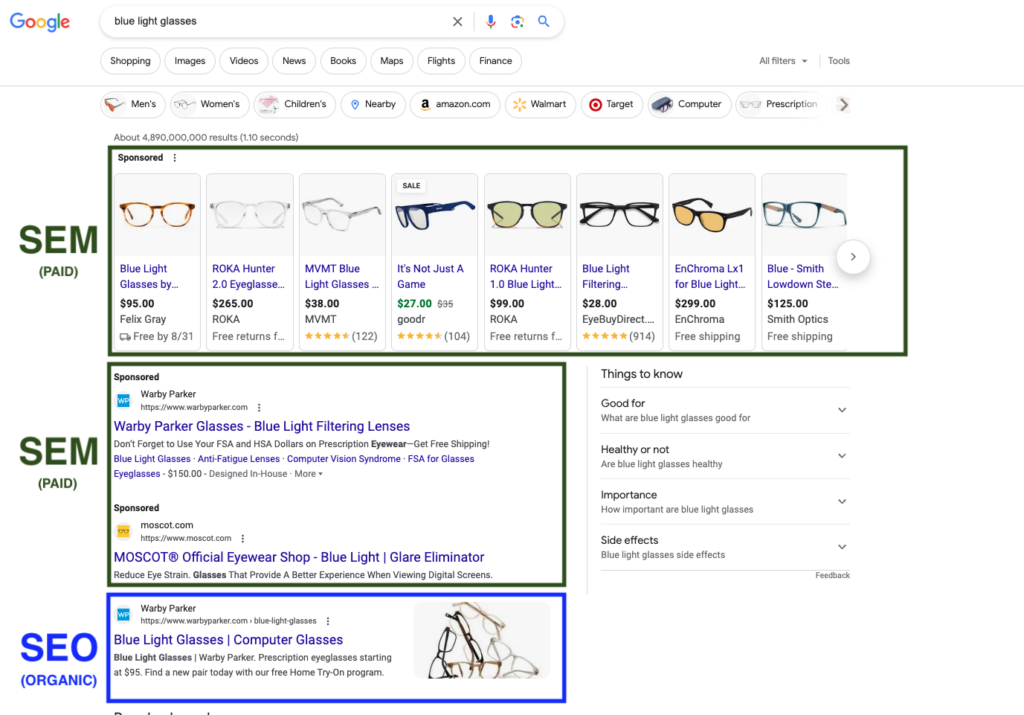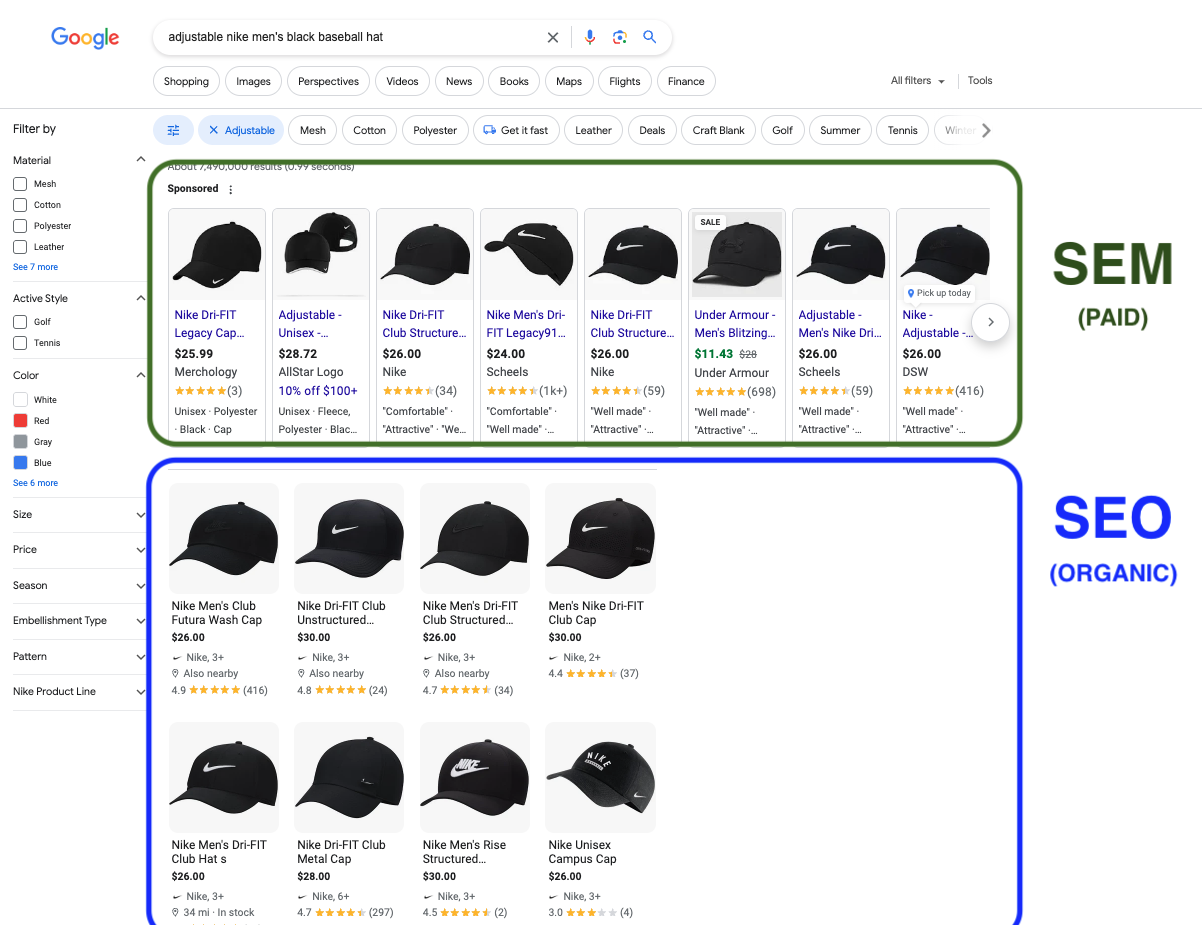
A strategic approach to Search is non-negotiable. Search Engine Optimization (SEO) and Search Engine Marketing (SEM) are two essential components of digital marketing strategy. While they are often considered two separate strategies, they can be most effective when used together. So let’s talk about how SEO and SEM work together to create a robust, integrated approach to growing your online presence!
First, Defining the Terms
SEO (Search Engine Optimization)
SEO is the process of organically optimizing your website to rank higher in search engine results pages (SERPs). This involves tweaking various elements of your website, including the content, site structure, and meta descriptions, and promoting your content with links from other websites.
SEM (Search Engine Marketing)
SEM, on the other hand, encompasses efforts to increase a site’s visibility through paid advertising. This typically involves bidding on keywords relevant to your business so your ads appear in the sponsored section of SERPs.
Although there is a lot to consider with any marketing campaign, In almost every case, a brand will benefit from a strategy that includes both SEO, and SEM.

Here is another example where both the Paid (SEM) and Organic (SEO) results look similar, yet, the strategies for getting visibility are very different!
The Symbiotic Relationship
When SEO and SEM strategies align, they complement each other. By having strong SEO practices, your site may rank well organically. Pair that with targeted SEM campaigns, and you can essentially double your visibility on Google and other search engines.
The Frequency Effect
In addition to enhancing your overall visibility, we’ve observed an interesting trend: Your combined conversion rate tends to rise when site visitors encounter both your organic and paid listings, regardless of which link they ultimately choose to click on.
Seeing your brand appear multiple times acts as a subtle yet effective trust signal. It’s like a gentle, professional nod that says, “We’re here, and we’re reliable.” This repeated exposure, known as the ‘frequency effect,’ helps to solidify your brand’s image, making it more memorable and increasing the likelihood that the prospect will engage with your company.
Data Sharing
SEM can yield quicker results, and the data obtained from your paid campaigns can inform your SEO strategy. For example, you can identify which keywords are driving the most conversions through SEM and then incorporate those into your organic SEO strategy. With effective paid campaigns, you can also discover which messaging is most effective and apply these insights to enhance elements such as metadata and page copy to improve organic results.
Budget Efficiency
By understanding what keywords you are ranking for organically through SEO, you can be more strategic with your SEM keyword bidding. This means not wasting money on high cost-per-click (CPC) terms that you already rank for organically.
Crafting a Unified Strategy
Keyword Alignment
Make sure your SEO and SEM teams are working from the same keyword/topic list and that priorities are aligned. This ensures coherence between organic and paid strategies and allows you to dominate SERPs for your targeted terms.
Consistent Messaging
Ensuring that the meta descriptions, ad copy, and landing pages across both SEO and SEM efforts are consistent is crucial. This creates a cohesive brand message that signals reliability and professionalism to your potential customers. When a user searches for a term related to your business, they are likely to encounter both your organic and paid search results. If these touchpoints echo the same core message and tone, they not only reinforce your brand’s image but also build trust with the searcher. The searcher is presented with a unified front that’s easy to understand and engage with, thereby streamlining their journey from curiosity to conversion.
In addition, consistent messaging across SEO and SEM initiatives can also positively impact the performance metrics of both strategies. For SEM, a landing page that closely aligns with the ad’s messaging can improve the Quality Score assigned by search engines, which can lead to lower costs per click and better ad placements.
For SEO, a clear and consistent message across various pages helps in reducing bounce rates and increasing time spent on site—key factors that search engines consider when ranking pages. Thus, the symbiotic relationship between SEO and SEM extends to the finer details of execution, and harmonizing the messaging across these channels becomes an essential practice for achieving optimal results.
Regular Communication
We have learned that SEO and SEM teams need to be in constant communication. Regular communication to share insights, data, and strategy is essential. These collaborative sessions are vital because SEO and SEM are not isolated channels; they often overlap and interact in ways that can significantly impact the overall performance of a company’s search marketing efforts.
For example, if someone working on an advertising campaign decides to remove a few paragraphs of text from an important landing page to test the impact on conversion rate, this alteration could greatly impact that page’s SEO performance. A seemingly minor change from a SEM perspective, such as trimming content for clarity, could unintentionally compromise the page’s ability to rank well organically due to reduced keyword richness or altered user engagement metrics.
Likewise, in an attempt to improve a page’s rankings, an SEO team member might recommend changes to copy or page layout that inadvertently impact ad conversion rate or page quality score. These adjustments, while potentially beneficial for organic search performance, might conflict with the specific messaging and design elements that have been optimized for paid campaigns.
The SEM team’s data on keyword performance can be a goldmine for the SEO team. This information can guide the SEO strategy, helping to prioritize certain keywords for content creation and on-site optimization based on what is proving to convert well in paid campaigns. On the flip side, the SEO team’s insights into organic search trends and user behavior can help the SEM team refine their ad targeting, potentially saving money by avoiding overly competitive terms where the site is already organically strong.
Alignment between these teams can prevent conflicts and redundancies. For instance, without proper communication, SEM campaigns might end up competing with SEO for the same keywords, driving up costs unnecessarily and causing internal competition for the same traffic. Such scenarios can be avoided when there is open and regular dialogue between these teams.
Fostering a culture of communication between SEO and SEM teams is more than a best practice—it’s a strategic necessity. Their collaboration can lead to a more holistic and efficient approach to search marketing, one that takes advantage of the strengths of both paid and organic strategies, resulting in a stronger, more cohesive online presence.
Monitoring and Adjusting
A unified SEO and SEM strategy is not a ‘set it and forget it’ deal. It requires ongoing analysis and adjustment. Use tools like Google Analytics and Google Ads data to track performance metrics and make data-driven decisions.
Now for some common questions we get asked all the time that are a bit more nuanced.
Should You Bid on Keywords You Already Rank For?
This is a common question among digital marketers, and the answer isn’t a straightforward ‘yes’ or ‘no.’ It depends on various factors, including your business goals, budget, and competition level. Let’s dive into the pros and cons of bidding on keywords you already rank for organically through SEO and under what circumstances this strategy might make sense.
The Pros:
Dominating the Search Results Page
By bidding on keywords you already rank for, you can occupy more real estate on the SERP. This double visibility reinforces your brand and increases the likelihood that users will click on your website over a competitor’s.
Fighting Off Competition
Even if you rank organically for a keyword, competitors might be bidding on that same keyword. By also engaging in SEM for these terms, you can prevent competitors from taking the top spot on the SERP and siphoning off your potential customers.
Controlling Your Narrative
Search ads allow more control over the messaging and landing page. This is a chance to highlight special promotions, new products, or specific calls to action that your organic listings might not.
Shopping Ads
If you’re an ecommerce brand, you have the added benefit of showing up at the top of the page in shopping results which gives you the opportunity to display a nice visual of your products along with their price which is what most searchers care about.
The Cons:
Increased Costs
Bidding on keywords you already rank for means you’re paying for clicks that you might have gotten for free through organic search. This can quickly eat into your marketing budget if not managed strategically.
Possible Cannibalization
There’s a risk of your search ads cannibalizing clicks that would have otherwise gone to your organic listings, resulting in paying for traffic you might have received at no cost.
Complex Management
Balancing SEO and SEM for the same keywords can be complex and requires a keen eye on analytics to ensure you’re not merely shifting clicks from organic to paid, rather than generating additional traffic. For this reason, partnering with a knowledgeable agency proficient in both areas is highly recommended.
So, Should You Bid on Keywords You Already Rank For?
Consider Your Business Goals
If brand visibility and awareness are your primary goals, then doubling up with SEO and SEM on the same keywords can be beneficial. If budget efficiency is your top priority, you might want to be more selective.
The Competitiveness of the Keyword
For high-competition keywords, where numerous competitors are bidding aggressively, maintaining both organic and paid presence can be crucial to sustaining visibility.
Your Budget
If you have a limited budget, you might want to prioritize SEM efforts on keywords where you aren’t already strong organically to maximize the reach of your spend.
In essence, there’s no one-size-fits-all answer. It requires careful analysis of your business situation and goals. Regular communication between your SEO and SEM teams, along with diligent monitoring of your analytics, will enable you to make data-driven decisions about where to allocate your budget for maximum impact and efficiency.
Should You Bid on Your Own Brand Name?
Bidding on your own brand name in SEM, known as ‘brand bidding,’ is a strategy that has sparked much debate among marketers. Is it a smart move to safeguard your brand or are you paying for something you could get for free? Here, we break down the pros and cons of this tactic and outline when it might make sense for your business.
The Pros:
Control Over Your Brand’s Narrative
Bidding on your brand name allows you to control the first thing that users see when they search for your brand. You can tailor ad copy to highlight specific promotions, emphasize unique selling propositions, or guide users to a particular landing page.
Defending Against Competitors
Competitors can (and often do) bid on your brand name. If they do, their ads might appear above your organic listings. Bidding on your own brand name ensures you maintain the top spot and prevent competitors from hijacking your brand’s traffic.
Enhancing SERP Presence
Search ads, especially when combined with rich ad extensions (like site links, callouts, etc.), can dominate a significant portion of the SERP, pushing down organic results and giving your brand more visibility and authority.
Enhanced User Experience Control
Bidding on your brand name allows you to craft a more controlled and targeted user experience than your organic listing might offer. You can design your ad to align perfectly with your brand voice and desired customer journey.
Strategic Traffic Direction
By bidding on your own brand, you can drive traffic directly to specific pages of your site, such as a new product launch or a special promotion. This targeted approach can significantly boost your conversion rate.
Optimized Headlines and Descriptions
Ads give you the freedom to test and tweak your headlines and descriptions. This enables you to discover what resonates most with your audience and can lead to a noticeable increase in your click-through rate (CTR).
Leverage Ad Extensions for Impact
Bidding for your brand name allows you to utilize site links and other ad extensions. These features not only increase your ad’s CTR, but they also make your listing more prominent and informative, giving you a competitive edge in the search results.
This approach ensures you stay in the driver’s seat when it comes to how your brand is presented in search results, and it offers strategic advantages for guiding potential customers to the most relevant and compelling parts of your site.
The Cons:
Increased Costs
You’re essentially paying for clicks on your brand name—clicks that you might otherwise receive for free through organic search results. For well-established brands with strong organic presence, this could lead to unnecessary costs.
Potential for Cannibalization
Just like bidding on keywords you already rank for, bidding on your brand name might shift clicks from organic to paid, rather than generating additional traffic.
So, Should You Bid on Your Own Brand Name?
Competitor Behavior
If competitors are regularly bidding on your brand name, you likely need to defend your position with your own ads. If they are not, you might actually save money by focusing your paid media budget on non-brand keywords.
Your Brand’s Strength
For new or lesser-known brands, bidding on your own name can help establish your presence in search results, especially if you do not yet control the first organic position for your brand name. For well-known brands with a solid organic presence, the necessity may be lower.
Your Marketing Budget
Consider the cost-effectiveness. If brand bidding proves to have high conversion rates at a low CPC, it may be worth the investment. Conversely, if you’re on a tight budget, scrutinize whether these funds could be better spent elsewhere.
Analysis of Traffic and Conversions
Diligently monitor how brand bidding impacts your traffic and conversion rates compared to organic search traffic. If it significantly boosts conversions without cannibalizing organic traffic, it’s likely a good strategy.
The decision to bid on your own brand name is not black and white; it’s shaded by various factors like competition, budget, and brand strength. The key is to continuously analyze the data and adjust your strategy based on what you observe. Regular consultations between your SEO and SEM teams, paired with a deep dive into the analytics, are essential steps towards making an informed decision on this matter.
Merging SEO and SEM efforts is the key to an effective and result-driven search strategy. When these two disciplines work hand in hand, they complement and amplify each other’s efforts, leading to improved visibility, more efficient use of budget, and a harmonious user experience that aligns with your brand’s message. The integration of SEO and SEM is not merely a tactical alignment—it is a strategic partnership that can propel your online presence to new heights.
Are you ready to take your search strategy to the next level? Contact us to learn how we can support your holistic search strategy, seamlessly blending SEM and SEO to maximize your digital impact and achieve your business goals.





